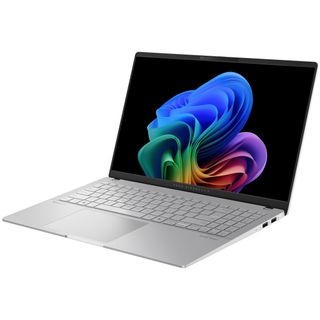Windows Central Verdict
Windows PCs finally have an answer to Apple Silicon in the form of Qualcomm's new Snapdragon X Elite, which elevates this laptop from a good one to a great one. With great performance, good battery life, an incredible screen, and an enjoyable keyboard and touchpad to boot.
Pros
- +
Snapdragon X Elite is incredible
- +
Gorgeous 15.6-inch OLED display
- +
3.2K resolution with 120Hz
- +
Good battery life
Cons
- -
16:9 aspect ratio isn't my favorite
- -
Trackpad should be haptic
- -
No touchscreen
Why you can trust Windows Central
It's the moment we've all been waiting for. The first wave of Copilot+ PCs is now shipping, and part of that wave is the new ASUS VivoBook S 15 with Qualcomm Snapdragon X Elite under the hood. We've been waiting months for a laptop with Qualcomm's latest chips to go on sale, and now we finally have one in hand to test.
I've been using the VivoBook S 15 for about a week, and I know this review is vital for many reasons. It's the first Snapdragon X Elite device we've tested at home in a device people can buy.
A lot is riding on these chips, being as good as Qualcomm has promised them to be. So, does the Snapdragon X Elite live up to the hype, and is the ASUS VivoBook S 15 a great Windows laptop overall? Find out in this review.
Disclaimer
This review was made possible thanks to a review unit provided by ASUS. The company did not see the contents of this review before publishing.
ASUS VivoBook S 15: Price and specs
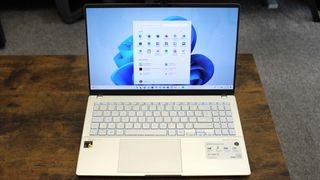
Price: $1,299.99
OS: Windows 11 Home
CPU: Snapdragon X Elite X1E78100
GPU: Qualcomm Adreno 3.8 TFLOPS
NPU: Qualcomm Hexagon 45 TOPS
RAM: 16GB LPDDR5X
Storage: 1TB M.2 NVMe PCIe 4.0 SSD
Display: 15.6-inch, 3K (2880 x 1620) OLED
Battery: 70WHrs, 3S1P, 3-cell Li-ion
Wireless: Wi-Fi 7, Bluetooth 5.4
Ports: 2x USB 3.2 Gen 1 Type-A, 2x USB4 Gen 3 Type-C support display / power delivery, 1x HDMI 2.1 TMDS, 1x 3.5mm Combo Audio Jack, Micro SD card reader
Size: 35.26 x 22.69 x 1.47 ~ 1.59 cm (13.88" x 8.93" x 0.58" ~ 0.63")
Starting Weight: 1.42 kg (3.13 lbs)
The VivoBook S 15 is ASUS' first laptop to ship with Qualcomm's latest system-on-a-chip. Under the hood, we're rocking a 12-core Snapdragon X Elite (X1E78100) at 3.4GHz, paired with 16GB RAM and 1TB SSD storage. This is the only configuration available in the VivoBook S 15.
The laptop includes a gorgeous 15.6-inch display with a high-resolution 2880 x 1620 120Hz OLED screen and thin bezels. It also has a full-sized RGB-backlit keyboard with a number pad and a large touchpad that sits just off-center to remain aligned with the main part of the keyboard.
For ports, we've got a healthy selection consisting of two left-side USB4 Type-C ports, a full-sized HDMI 2.1 port, a microSD card reader, and a 3.5mm audio jack, along with two right-side USB-A 3.2 Gen1 ports. The device charges via USB-C, meaning there's no dedicated or proprietary charging port or cable in the box.
Reviewed Configuration
Qualcomm Snapdragon X Elite X1E78100 | 16GB RAM | 1TB SSD
This appears to be the only configuration of the ASUS VivoBook S 15 available to purchase right now. It costs $1,299, which nets you a gorgeous OLED screen, excellent keyboard and trackpad, and a large battery that should last you all day.
ASUS VivoBook S 15: Copilot+ features
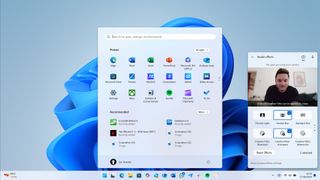
The big selling point of these Copilot+ PCs is the exclusive set of features you can only find on these devices. These features include live caption translations, Windows Studio Effects, Cocreator in Paint, and image generation in Photos.
However, the one flagship feature for Copilot+ PCs, Recall, has been postponed due to controversy over security concerns. While this laptop is getting Windows Recall, it will only be available initially through Microsoft's Windows Insider program as a "Preview" feature until it reaches maturity for general release.
All of these Copilot+ features are handled locally on device, powered by Qualcomm's new Hexagon NPU that outputs 45 TOPS of power. This power is most noticeable when generating images in Photos, which takes a little under 10 seconds to propagate results once you type in a query. Before you ask, yes, Photos will reject certain key phrases.

The image generator in Photos and Cocreator in Paint follows a similar principle: an image generated using AI based on the user's inputted prompt. Cocreator in Paint follows your drawing to bring to life whatever basic sketch you've put together in Paint, whereas the Photos app generates an entire image based on your prompt.
I can't say either of these features has blown me away, partly because I have very little use for AI-generated imagery in my day to day. I'm sure there will be people out there who find these useful, but I think those people might be better served using an online image generator that's more realistic. Photos images are very "artistic," which is likely a deliberate choice to avoid spreading fake images that look real.
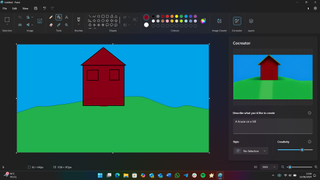
I think the best Copilot+ feature is the enhanced Windows Studio Effects, which simply look great. There are three illustrative effects that you can apply to your webcam feed, which make your skin look great, almost like Snapchat filters. There's also a virtual portrait light mode, which attempts to brighten your face using AI, along with a more realistic portrait blur that looks really good. I will talk more about the Windows Studio Effects in the camera section of this review.
Lastly, I want to mention something I've not experienced on a Windows laptop before: consistent waking from sleep when opening the lid. Most Windows laptops will hibernate after a few hours of not being touched, meaning it takes longer to wake from sleep. This isn't something the Mac does, and so far, the ASUS VivoBook S 15 doesn't do it either. Every time I've gone to open the lid, it's instantly awake and ready for me to start using. It's really awesome.
ASUS VivoBook S 15: Design and ports
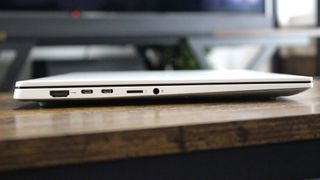
Starting with the overall design of the VivoBook S 15, I think it looks perfectly adequate for the price you pay. It's unmistakably a Windows laptop, complete with a number pad to the left of the keyboard and an off-center touchpad to match. It's a fine-looking contemporary clamshell laptop that's inoffensive to the eye, making it an excellent choice for professionals working in an office space.
For those looking at this laptop for its number pad, it should be noted that it is squashed here. It's not a "fully-sized" number pad, but it still has all the essential buttons to punch numbers in an Excel spreadsheet.

- Best gaming laptops
- Best Windows laptops
- Laptop review and buying guides
- Best gaming headsets
- Best gaming monitors
The chassis is made of magnesium alloy, which is cold to the touch and feels excellent in the hand, though there is a small amount of flex to the keyboard deck and lid when closed. The device is quite sleek, just 0.63 inches at its thickest point.
The laptop is also incredibly light for its size. Coming in at just 1.42kgs (3.13lbs), this 15.6-inch laptop can be easily picked up with one hand, making it an excellent option for those needing a travel laptop with a large screen. You won't even notice it in your backpack.
It also passes the one-hand opening test, revealing that gorgeous 15.6-inch display. That display is surrounded by noticeably thin bezels, which look great. The top and bottom bezels are slightly thicker than the side bezels, but those side bezels are almost invisible with how thin they are.
Built-in to the chassis is an excellent selection of ports. Two USB-A 3.2 Gen 1 ports are on the right, next to a charging and power LED. On the left side, we have two USB-C 4.0 ports, a microSD card reader, a 3.5mm headphone jack, and a full-sized HDMI 2.1 port for outputting an image to an external display or projector.
ASUS VivoBook S 15: Display

If it weren't for the silicon on the inside, I'd call the display the star of the show here. It's a 15.6-inch OLED panel with a screen-to-body ratio of 89%, featuring a 2880 x 1620 resolution and a dynamic 120Hz refresh rate. In short, it's a beautiful display with smooth and crisp visuals, helped by the fact that this laptop display is of the glossy variety.
I prefer glossy displays over matte ones, as they help with text clarity on Windows. That said, it's worth noting that this glossy display doesn't have an anti-reflective coating, meaning you won't want to position this screen directly facing a window; otherwise, you'll struggle to see your work.
This display uses OLED technology, which means colors pop with a contrast ratio of 1,000,000:1. It also supports HDR content, with a peak brightness of around 600 nits. Colors are also accurate with a 100% DCI-P3 color gamut.
This display has only two notable downsides: the aspect ratio and lack of touch support. The display is a 16:9 panel, which some people still prefer, but I find it a little too cramped horizontally after using 16:10 and 3:2 displays at this screen size. This means you must scroll extra to view webpage content or documents.
The display also lacks touch support, which probably isn't a big deal to everyone. But when you're spending $1,300 on a Windows laptop, I feel it should at least be an option for the user to select during checkout.
ASUS VivoBook S 15: Performance and battery life
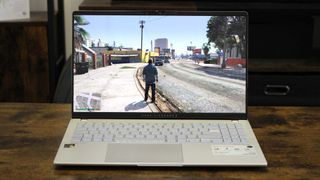
So, does the Snapdragon X Elite live up to the hype? In short, it absolutely does. This chip is a beast, outputting incredible performance that you can feel in almost every task. Whether browsing the web with lots of tabs, multitasking through lots of open apps, rendering video and audio, hosting a podcast, or even some gaming, The Snapdragon X Elite can do it all.
The ASUS VivoBook S 15 chip is the "entry-level" X Elite configuration, specifically the 3.4GHz X1E78100 with 12 cores and 12 threads. There are three configurations of the X Elite, with the two others (X1E80100 and X1E84100) being slightly more capable with the ability to boost performance on two cores. The GPU on the X1E84100 variant is also more powerful, outputting 4.6 TFLOPS vs 3.8 TFLOPS on the X1E80100 and X1E78100.
In day-to-day usage, you won't notice the difference between these configurations, with the most significant disparity being the GPU performance output that you will likely only notice during gaming.
The ASUS VivoBook S 15 includes a 45W TDP variant of the X1E78100, which means it can reach higher levels of performance compared to other Copilot+ PCs with this chip thanks to its thermal envelope allowing the chip to run hotter under maximum load. ASUS says this allows the chip to run 31% faster, but this does come at the cost of some battery efficiency.
Benchmarks
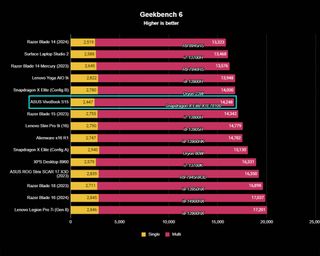
So, does the Snapdragon X Elite live up to the hype in benchmark results? At least in the ASUS VivoBook S 15, the answer is yes. In almost all our tests, the Snapdragon X Elite trades blows with the Apple M3, and beats Intel's high-end Core i7 and Core i9 chips in certain laptops. Our Geekbench results saw the ASUS VivoBook S 15 earn a score of 2,447 in single-core and 14,248 in multi-core, just about in line with what Qualcomm promised these chips would deliver.
It beats the Surface Laptop Studio 2, which, up until Copilot+ PCs, was Microsoft's most powerful laptop. It also beats the Lenovo Yoga AIO 9i, a literal desktop computer with an Intel Core i9-13900H, and it's even 600 points higher in multi-core than the AMD R9 7940HS found in the Razer Blade 14.

Cinebench 2024 also benched well, with a single-core score of 108 and a multi-core score of 1128. This places it ahead of the latest Razer Blade 14 and beats the Samsung Galaxy Book4 Ultra with Intel Core i9 and HP OEM Transcend 14 with Intel Core Ultra 7. It's fair to say the Snapdragon X Elite in the ASUS VivoBook S 15 is a beast.
It also earned almost double the performance points compared to the ThinkPad X13s in CrossMark, earning a score of 1007 vs the ThinkPad's 656, which features a Snapdragon 8cx Gen3. Regarding disk performance, the ASUS VivoBook S 15 ships with a high-speed drive, coming in at 5,024 MB/s read and 3,631 MB/s write, putting it up there with the SSD performance found in the Lenovo Slim 7i and Dell Latitude 9440.




Unfortunately, we could not get our benchmarking software to measure the performance of the NPU. We're waiting for a driver and software update to fix this. We will update the review once we can successfully run that benchmark. We know that the NPU in this laptop is the most powerful NPU on the market that you can currently buy, outputting around 45 TOPS of power.
Emulated app performance

Emulated apps run great for the most part. There are likely some exceptions, of which I could only find one, but your usual apps should now run with little to no hiccups. The biggest issue emulated apps had before was that they ran slower, and this was primarily evident when switching between UI panes or scrolling. No longer is this a problem in most apps.
For example, XSplit is an app I used to host the Windows Central Podcast, and until now, I have never been able to run it successfully on a Windows on Arm laptop. It would always freeze and drop frames because the chip and emulation layer weren't good enough. Now, XSplit behaves beautifully, as if it were native to Arm.
So, what was the exception I mentioned? I could only find one that I could tell would benefit from being Arm64 native: Adobe Premiere Pro. On these new devices, Adobe finally lets you run Premiere Pro under emulation, but Premiere Pro is a massive application that's very heavy even on Intel systems, so unsurprisingly, it doesn't run amazingly here.
Can you edit and render a video with it? Yes! But your experience will depend on the kind of video you're editing. You should be golden if you're editing a simple 1080p 30fps video. You will see the app struggle if you're working with multiple layers and effects or 4K and 60fps. You'll see frame-dropping in the timeline preview feed and rendering the video will take longer than on an Intel machine.

These issues will be solved when Premiere Pro is made available natively on Arm, which Adobe says it is working on. When this happens, video editing in Premiere Pro should match the experience found on Intel machines. The chip is definitely capable, but the emulation layer is letting it down somewhat here. In fact, I had a much smoother time editing videos in DaVinci Resolve, which is Arm64 native, and rendered the same video project in half the time it took to render in Premiere Pro.
Under general use, the ASUS VivoBook S 15 doesn't get hot, and the fans are barely audible. Under load, the fans do come on, but unless you manually set them to max speed, they'll never spin up that high or get obnoxiously loud. When under max load, I measured a temperature of around 107F just above the keyboard, which is a little toasty. This was with the fans set to standard mode. If I turned them to maximum performance mode, that temperature would be around 100F.
On the subject of those fans, as I mentioned, they're rarely audible, but you can configure them to speed up under load. In performance mode, the fans registered around 30dB, which is perfectly acceptable. On maximum fan speed mode, they got pretty loud at 42 dB. As far as I can tell, the fans never spin up that fast on their own; you have to manually set them to maximum to hear them this loud.
Gaming

The ASUS VivoBook S 15 is by no means a gaming laptop. In fact, none of the Copilot+ PCs launching this summer are gaming laptops in any sense of the word, but I still wanted to try anyway. So, I've loaded up some games to see how well they perform under emulation and the new Snapdragon chip.
The first issue I encountered was that the Microsoft Store wouldn't let you download most games, as many were listed as only compatible with x86 processors. This is unfortunate, as I know many of these games would probably work if the store just let me download them. So, it quickly became apparent that other gaming storefronts would be our best bet.

So, I loaded up Steam and began downloading some games. The first three games I tried were Halo Infinite, Halo MCC, and Apex Legends. All three of these games refused to let me play, throwing up an error that stated, "ARM64 CPU not supported." This seems like a hard-coded block, and I'm guessing these games would at least run if the launchers allowed me to try.
Luckily, not all games are hard-coded to refuse entry if on an ARM CPU. GTA V loads and runs shockingly well, considering it's running under Microsoft's PRISM emulation layer. At 1080p, I could average 60-70fps on medium to high graphics settings. I'd happily play this game from beginning to end on a Copilot+ PC.

I also tried Marvel's Spider-Man Remastered, a more recent and graphics-heavy game. I had some issues with this, but the game does run. At 1080p low-medium graphics, I was able to hit around 40fps on average. However, there were some noticeable graphical glitches in cutscenes, where hair was clearly not rendered properly. Outside of cutscenes, the game was mostly playable, but I personally wouldn't want to experience this game on a Copilot+ PC.
The game would also crash if I tried running the game on anything higher than medium graphics. Unfortunately, the game runs on high graphics settings for a short while with little impact on performance, but the laptop runs out of GPU RAM and crashes.

Cyberpunk 2077 was next on my list, and it does run, but barely. I could barely achieve 30fps at 1080p on low graphics, with the benchmark saying I only averaged around 24-26fps. So, this isn't the kind of game you'll want to play on a Copilot+ PC, but I was impressed that it could even run under emulation.
Overall, the ASUS VivoBook S 15 can play older games, but it will probably struggle with more recent AAA titles. Once again, this isn't a gaming laptop, to begin with, so the fact it can even attempt to play games at reasonable frame rates is an achievement on its own, especially considering no games we tried were natively compiled for ARM. Everything was running under Microsoft's emulation layer, and for the most part, they ran pretty well.
Battery life
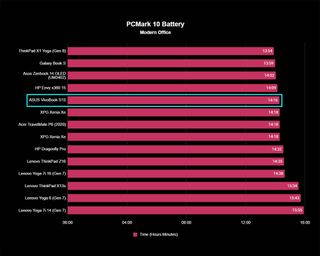
Getting on to the battery life could be the make-or-break moment for many people. The laptop has a 70Whr battery cell, which is on the larger side for a Copilot+ PC, and I'm happy to report that the ASUS VivoBook S 15 does get good battery life, even with its (up to) 45W TDP chip.
The PCMark10 Applications battery test came in at 14 hours and 16 minutes. While these numbers don't break any ground, these are some of the better battery life numbers we've seen from a 45W chip, and the benchmark test alone isn't always an ideal measurement of battery life.
In my usage of the laptop, this thing lasts and lasts. With no worries about battery life, I can get through an entire workday with your usual web browsing, email, and office workflow. I can even get through much of the following day on the same tank of energy before I feel obligated to plug it in to recharge.
Curiously, by default, the laptop is set to switch to a custom "power efficiency" profile when unplugged from the wall. This is unusual, as most laptops will opt for the "balanced" power profile when unplugged. We ran our battery life test with this balanced power mode, along with how I generally used the laptop.
The power efficiency profile will underclock the CPU down to around 1Ghz, which is fine for light tasks such as web browsing or office work, but you'll want to set it to balanced for most other tasks when away from the wall.
ASUS VivoBook S 15: Keyboard and touchpad

Moving around to the keyboard and trackpad, both are very good on this laptop. Starting with the keyboard it's a full-sized keyboard with a slightly squished number pad on the right side.
This keyboard also features a fully customizable 1-zone RGB backlight, which can be configured using Microsoft's built-in Dynamic Lighting feature in the Windows Settings app. It is a surprising but appreciated addition for a laptop that isn't aimed at gamers and features a clean and professional design, including an RGB backlight.
Because it's RGB, the user can choose the backlight's color. It's set to your Windows accent color by default, but you can set it to any color you like in the Windows Settings app. I've had it be red, yellow, and blue. You can also set the backlight to white for those who prefer a neutral color.
Windows includes six different effects for the backlight that you can apply to the keyboard deck:
- Solid
- Breathing
- Rainbow
- Wave
- Wheel
- Gradient

The touchpad is also pretty good, using precision drivers, meaning it supports all the same smooth gestures and scrolling as other high-end laptops. While it's not the biggest touchpad on the market, it's still a great size, and I've had no issues using it on this laptop. Even the clicking sound is nice and subtle.
The only real complaint I have with the touchpad is that it's not a haptic touchpad, meaning it uses a more traditional dive board mechanism with a physical click. If that's something you prefer, great. However, haptic touchpads are better as you can click down on them anywhere, and this touchpad doesn't have that.
ASUS VivoBook S 15: Camera, mic, and audio
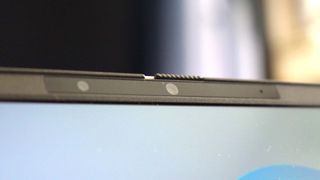
The VivoBook S 15 features a passable 1080p webcam positioned in the center of the top bezel. Picture and video quality is okay in well-lit environments, though it's not very sharp. Camera quality gets noticeably worse in low-light scenarios. The camera does include a physical privacy shutter that can be slid open and closed manually, which is an excellent addition.
The camera is elevated somewhat by including new advanced Windows Studio Effects exclusive to Copilot+ PCs. These effects are powered by the included neural processing unit, meaning they run smoothly no matter what apps you're using.
The new Windows Studio Effects can be enabled via the Windows 11 Control Center and applied system-wide to work in any app calling upon the webcam feed. The new effects include:
- Virtual portrait lighting
- Illustrated filter
- Animated filter
- Watercolor filter
The virtual portrait lighting toggle applies an effect that subtly brightens up faces in shots, which can be helpful but does little to reduce noise artifacts in low-light environments.

The more impactful effects are the filters, of which there are three to choose from. All three are like applying a Snapchat filter to your live webcam feed, and they all look pretty great (and are rather flattering, if I do say so myself.) I don't know if you'd get away with using these in a serious work meeting, but when chatting with friends, they're a lot of fun and can help cover up any skin blemishes or other imperfections that you may be experiencing at any given time.
The laptop also supports Windows Hello face unlock, which works well for the most part. It uses IR sensors in the top bezel to scan your face and securely stores that locally on your device, just like Face ID on an iPhone. Unlike Windows Hello on my Surface Laptop, however, the ASUS VivoBook S 15 seems to take a little longer to kick in from sleep.
I've noticed myself waiting a beat or two on the lock screen for the Windows Hello service to wake up when I open the lid. It's not a big deal, but it's something I've noticed I don't have to do on some other Windows Hello-enabled laptops. I've also noticed that sometimes Windows Hello fails to recognize me in the dark, which is another problem I've not had on my Surface Laptop before.
Moving onto the built-in microphone, the ASUS VivoBook S 15 has a great set. Microphone quality is crisp and clear, with no buzzing or clipping unless you max out the gain of the microphone in the Windows Settings app. I set mine to around 90% volume, and the microphone sounds good. You can also enhance it with Windows Voice Focus, which uses AI to filter out background noise and only focus on your voice.
Lastly, we have the built-in speakers, which are fine. They're certainly not the best built-in speakers I've ever heard, but they're also not the worst either. The speakers are compatible with Dolby Atmos and have been tuned by Harman Kardon, but this doesn't amount to much. The speaker quality sounds a bit muffled compared to my Lenovo Yoga 9i 16, which has some of the best laptop speakers in the Windows world.
This is likely because the speakers on the VivoBook S 15 are down-firing, meaning your legs or the desk easily muffles them.
ASUS VivoBook S 15: Competition
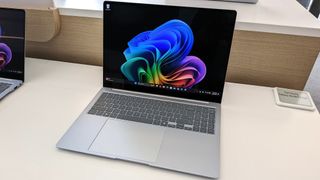
The Copilot+ PC market is rife with competition, with all the big-name Windows hardware makers now shipping hardware under this umbrella, with plenty of options around the same price bracket as the ASUS VivoBook S 15.
The Surface Laptop 7 15" starts at $1,299 for the same Snapdragon X Elite chip and 16GB RAM, but with less storage at 256GB. I think the Surface Laptop 7 has an overall better design (and more colors) than the ASUS VivoBook S 15, but that comes at the cost of storage and a slightly lower resolution display but with the bonus of touch.
I think a more comparable laptop is the Samsung Galaxy Book4 Edge, which is Samsung's Copilot+ PC offering. The 14-inch model comes with the slightly more powerful Snapdragon X Elite X1E80100, with 16GB RAM and 512GB SSD storage for $1,349, just $50 more than the ASUS. It's lighter at 1.18 kgs (2.6 lbs) and has a better 16:10 aspect ratio display with touch and a haptic touchpad, but a smaller battery at 55Whr.
ASUS VivoBook S 15: Should you buy it?
✅ You should buy this if...
- You're looking for a workhorse for the office and on the go.
- You want a large screen with high-resolution and refresh rate.
- You want all day battery life and a good keyboard/touchpad.
- You need a Copilot+ PC with a 45W TDP.
❌ You should not buy this if...
- You use obscure software that might not work on Windows on Arm.
- You want to game.
- You need to edit video in Premiere Pro (for now.)
The ASUS VivoBook S 15 is the first Copilot+ PC I've ever used, and I'm glad it was. This laptop is a joy to use, and while it makes some choices that don't align with my personal preferences, I can see it's a great all-rounder that most people will be more than happy with for $1,299. For that price, you get an incredible screen, good battery life, and excellent performance in a chassis that's high-quality and professional.
The Snapdragon X Elite elevates this laptop from a good one to a great one. If it were an Intel laptop, it wouldn't be that special, but Qualcomm's new chip is genuinely impressive, allowing this laptop to do much more than you might expect. It's a competent video editor and multitasker with excellent AI capabilities that, up until now, hasn't really been viable in a laptop this thin and light, and certainly not for $1,299.
The ASUS VivoBook S 15 is the only Snapdragon X Elite PC on the market currently that ships with a 45W TDP, which does give it an extra boost in performance, but it's still early days to know just how that compares to the competition. If you need a higher TDP, this is the laptop to get.

-
dharmababa Probably not the hardware that most are waiting for but answers most of the major questions people have had. People who were claiming/hoping that Qualcomm was going to flop are obviously wrong:Reply
The Snapdragon X will provide performance between M3 and M3 Pro which is excellent for a "first" outing (Oryon v1). It does not need to compete with M4 to be a huge step forward for the Windows ecosystem.
Yes it requires fans but they're quiet and it's a trade off for better sustained multi-core.
Emulation will be a slight hit but generally close to Rosetta.
Battery life improvements (incl sleep/wake) are significant - some promising reports from r/Surface as well.Microsoft really should have focused on marketing the perf/battery aspects of this (M1 moment) but they obviously couldn't resist the temptation to lump AI/Recall in especially with the NPU and industry hype bubble around AI. I personally couldn't care less about the Recall delay and can't wait until my SL7 arrives for the improved fundamentals. Basic stuff like studio effects are nice. -
The Werewolf I'm genuinely bewildered by this desperate need for a platform with 85% of the market to prove itself "better" than one company's product that has 15% of the market.Reply
If you look at the benchmarks here - this laptop is at best mid-range in comparison to other laptops and at 45W TDP isn't even particularly different in terms of thermals. Pricewise, at least right now, these are all higher end laptops. I just picked up an ASUS Zenbook 14 i7 laptop with a 14" OLED screen (same basic screen as this one, but with touch and pen support) for CA$1150 (US$840).
There's nothing wrong with this ARM laptop, but for most people, there's really nothing special about it either. I can't imagine people running out to get a laptop because it can genAI your photos... and not play many games.
I know WindowsCentral (and Zac in particular) has a serious b****r for ARM, but objectively, it's just a laptop, one of many in many configs. Nothing so far (especially Copilot+) stands out as a reason run out and get one or choose it over an Intel or AMD laptop.
About the only big takeaway for me? If this is equivalent to the performance level of an M3 MacBook... WOW is that device overhyped given its price. -
Grimlock I'm very surprised that Microsoft put the entire weight of the company behind these chips and they not live up to the hype. I'm not saying they're flops either, they've definitely made a leap forward, but to say they were ahead of the competition on performance and efficiency simply isn't true. I think if they had tempered expectations a bit the narrative around these chips would be quite positive.Reply
The battery life seems marginally better than AMD/Intel right now, but that will likely change in the coming months with lunar lake and zen 5. I really like the standby performance on the snapdragon, but if will always come at the cost of using prism I don't see a significant number of people leaving amd/intel for these devices.
Ultimately I don't think the push for developers to offer ARM software will improve dramatically over the next year, and windows on arm will be non existent in a couple years sadly. -
Arthur Dent With respect to battery life remember that the VivoBook has an OLED monitor, which typically puts it at a disadvantage when comparing it to machines (like a MacBook) that do not have an OLED screen. See for exampleReply
https://www.batterypoweronline.com/news/oled-displays-impact-on-battery-life-for-consumer-tech-devices/
https://www.notebookcheck.net/HP-Spectre-x360-13-OLED-battery-life-is-significantly-shorter-than-the-IPS-option-by-several-hours.539603.0.html
It depends on what is used for the battery tests - if it is using a lot of white or bright windowed content that will negatively affect an OLED's efficiency more than the other screen types, perhaps significantly.
We really need to see the battery tests for non-OLED systems. The VivoBook's battery life might actually be very good given that it has the OLED screen.



